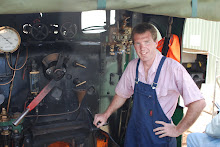Over the last week I have been working hard on dogbox no.1 spending just a couple hours each night when I get home from work. In the last post I managed to finish off the bogie's, however after posting I was contacted by Mike McCormack about the bogie headstocks. I have been in contact with Mike several times during the construction process and he has been a huge help and great inspiration. Great after sales service. As I had changed my mind about the couplings I will use, I assembled the bogie's with the headstock's suited for the KD boxes with what was supplied in the kit. They dip down in the centre to clear the KD. Mike was kind enough to send me the correct plain headstock's for use with the screw type couplings as per the prototype. He also included some small delrin sleeves so as the buffers can be sprung, an important addition when using hook draw gear (more on this later). I have yet to swap these over. For those who are considering one or two of these kits, might be an idea to think about this before you order. Mike will supply the kit to suit.
I then started work on the Body. The body sides are just superb. The scale 2” tongue and groove siding is just beautiful. To achieve the correct appearance for the droplight windows a separate etch for the window frames are provided. The droplight frames are painted before separating from the fret and after they have been fixed in position, there will be a clean, sharp definition between the Venetian/Tuscan Red frames and the Russet window band. They can be modelled in open or closed position as well for extra character. The sides have been machined as matched sets and must not be mixed up. Very minimal clean up is needed. One of the things that make these kits so good is the several assembly jigs that are supplied with the kit. The use of these makes assembly so easy and so far have found the kit to go together easier than say an AR Kits wagon. The below images show the jig used to align the internal WC walls to the body sides. The jig slips nicely into the WC window, then wall sections can be glued into position either side of the jig.


 |
| The completed body showing internal compartments |
Take note of the detailed seats and door details. The seat cushions are profiled to the right shape as well. Simply amazing!
Once the body is assembled there are a couple of small details that need to be constructed. One of these is the switch lever on the end of the car. The switch lever and brackets are made from a brass etch and in order to produce a scale 1” square section two separate etches of the lever arms need to be soldered together. This was perhaps the fiddliest of all the construction but care and patience will produce superb results. A spare lever is provided if one stuffs it up. Included is another jig to aid in filing the edges after soldering. I have chemically blackened these ready for installation after the body is painted. The roof is held in place by three brass screws that come up through the closed section of the WC compartment making it easy to access the interior of the car for further detailing after assembly. Also look at the detail of the end roof cornice.
 |
| Switch box and lever. |
 |
| This is the other end of the car with the steps in place. The roof is just sitting in place for the photo and is not yet screwed right down. |
Now onto the underframe. Most urethane kits struggle to produce correct step boards and have them cast into the underframe. These kits require the complete assembly of the step boards by using brass castings for the brackets and nickel silver strip for the boards themselves. There is also a small etch for the step treads that are applied after it’s all soldered together. The underfloor is first pinned to yet another Timber Jig that has been machined with a recess down the middle. The step board brackets have a small spigot on the bottom that slot into holes in the sole bar. These holes are drilled out through into the timber jig. Once all the holes are drilled the underframe is removed from the jig revealing all the holes correctly spaced for the step board brackets on the timber. All the brackets are now inserted into the holes in the timber and down onto the step boards. Once they have all been soldered together you simply remove the step board assembly from the timber jig. All the spigot holes will line up perfectly in the underframe. In the next few days I will tackle the rest of the underfloor detail of the underframe.
 |
| Cast brass stepboard brackets mounted in the assembly jig. One side has been soldered. |
 |
| All brackets in place ready for soldering. |
 |
| Here are the stepboard assemblies ready to be installed to the under frame. |
Below are the shots of the completed Body. Still need to add the roof vents and WC filler caps.
That's all for now.
Ian














